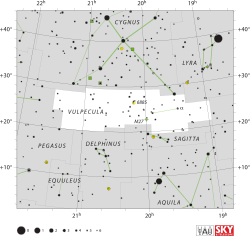19 Vulpeculae
| Observation data Epoch J2000.0 Equinox J2000.0 (ICRS) | |
|---|---|
| Constellation | Vulpecula |
| Right ascension | 20h 11m 47.97409s[1] |
| Declination | 26° 48′ 32.3663″[1] |
| Apparent magnitude (V) | 5.40[2] |
| Distance | 1,411[1] ly (433 pc) |
| Spectral type | K2 IIIa[3] |
| Other designations | |
| Database references | |
| SIMBAD | data |
19 Vulpeculae (19 Vul) is an orange supergiant star (K3I), approximately 1,400 light years from Earth in the constellation Vulpecula and proximity of the open clusters NGC 6882 and NGC 6885 (Caldwell 37).
External links
- 19 Vulpeculae on WikiSky: DSS2, SDSS, GALEX, IRAS, Hydrogen α, X-Ray, Astrophoto, Sky Map, Articles and images
References
- ^ a b c Van Leeuwen, F. (2007). "Validation of the new Hipparcos reduction". Astronomy and Astrophysics. 474 (2): 653. arXiv:0708.1752. Bibcode:2007A&A...474..653V. doi:10.1051/0004-6361:20078357.
- ^ Fernie, J. D. (1983). "New UBVRI photometry for 900 supergiants". Astrophysical Journal Supplement Series. 52: 7. Bibcode:1983ApJS...52....7F. doi:10.1086/190856.
- ^ Keenan, Philip C.; McNeil, Raymond C. (1989). "The Perkins catalog of revised MK types for the cooler stars". Astrophysical Journal Supplement Series. 71: 245. Bibcode:1989ApJS...71..245K. doi:10.1086/191373.

